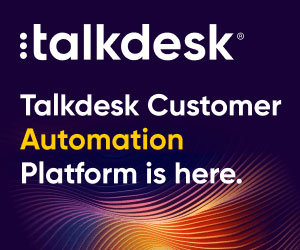This month, we’ve asked three key vendors – Fluency Voice Technology, Nuance and VoxGen – for their advice on speech recognition technology.
The five things you should consider when purchasing a speech solution
By Paul Barnes, vice president of global sales at Fluency Voice Technology

Speech recognition technology has almost unlimited potential to radically reinvent the customer contact experience while meeting all of a customer service director’s tough targets for call management efficiency and cost savings. The challenge is identifying the right speech recognition solution for your business. Resultantly, we have outlined a handful of key pointers to help ensure your speech initiative delivers the promised cost savings while also improving the customer experience.
1) Technology standards: proprietary versus standards
The biggest change in the speech recognition industry has been the move towards open standards software. Traditional touch-tone interactive voice response (IVR) systems were invariably proprietary and therefore complex, costly and required specialist skills to maintain. It’s important for you to protect your current IT and call centre investments by looking at language and platform independent applications based on standards.
2) Development options: packaged versus custom
Historically the only option open to customer service managers was to custom-build the application. This usually resulted in long development times and prohibitively expensive solutions which were difficult to maintain and were often inflexible. Packaged applications, on the other hand, offer a robust foundation extensively tried and tested in live situations. The case for implementing a packaged application is low risk, low cost and speed of deployment. However, it is essential that the supplier can show proof-points of these claims.
3) Deployment options – hosted versus customer premises equipment (CPE)
If your organisation prefers not to operate a speech system on your premises, lacks IT support or cannot withstand the initial capital expenditure, then a remote speech hosting solution could be the answer. On the other hand, a CPE solution will allow customers to take full control of the system internally and will also accommodate future company expansion. Ask the advice of experts before going ahead and purchasing a speech solution. A good provider will take the time to go through your needs in detail and then make suggestions based on your business requirements.
4) Guaranteed expertise
Due diligence should be a priority. Look for a vendor with proven leadership, good referenceable customers and a strong track record within the speech recognition field. To guarantee the success of your project, you should also look for an organisation that offers a full range of services and expertise related to a speech project. This will include a feasibility and scoping phase – one where you can ask if speech is right for your business; a speech implementation phase – incorporating voice user interface (VUI) design, tuning and personal development; and a post-implementation phase, including performance audits, support and so on.
5) Delivering flexibility and control to the call centre
The level of flexibility to modify and improve the speech system is an important consideration, especially as your business and customers evolve. The system should allow you to make changes through a sophisticated configuration user interface and system management console that provides secure access and central control of your speech system.

Discovery to optimisation – the rules that make speech recognition workBy Jennifer Axelrad, marketing manager, speech solutions, at Nuance (www.nuance.com)Many organisations are today feeling the pressure of decreasing margins in highly competitive markets. Yet at the same time they are being tasked with delivering premium customer service.
This shift has seen the traditional person-to-person customer experience model being supplemented or replaced by automated systems as companies aim to reduce costs and increase efficiencies in operations. However, implementing speech technology is much more than a route to simply making cost savings on agent wages. Customer experience can actually be vastly improved through a standardised approach that takes less call time than speaking to an agent.
Speech solutions typically deliver a range of benefits, including the ability to: process high transaction volumes on a 24×7 basis; deal with call volume spikes; offer caller verification so calls can be prioritised or intelligently routed; and record information not easily manipulated by touchpad – that is, alpha-numeric information such as a caller’s address.
Ultimately, the objective with any speech implementation is to build a service that delights callers and achieves measurable results coupled with improved return on investment (ROI). And thanks to exponential advances in the technology over the past few years – all of which have worked to make the kit more ‘friendly’ and natural to use – enterprises can now expect to realise a 6 to 12-month ROI from speech technology. However, to reap the maximum benefits, there are four key stages that purchasers should work through. These can be outlined as follows:
1) Discovery
Define your business, and the caller and system requirements. Ask what level of engagement you require with the customer and what information you need from the system. Think seriously about whether you want to drive customer care or transaction services through live agents. Other points of discovery may concern the technology you already have in place. Do you have issues with your existing legacy technology? Or are you moving to an Internet Protocol (IP)-based network? The answers to both of these questions could potentially impact on how you proceed with the next stage – design.
2) Design
A compelling user interface is critical. It can quickly, pleasantly and efficiently service your callers’ needs, while educating them on how to best interact with your speech system. A strong user interface will also deliver a powerful self service option for customer care and communication, while reinforcing your company’s brand.
One method that can really help in designing the customer interface is to ‘personify the brand’. Vodafone used this approach to create a ‘cyber agent’ called Lara to deal with all its calls.
3) Realisation
This is the stage where you develop, test and deploy the application. The solution needs to stand up in all conditions, the result of failure being lost customers. In other words, this is the time to raise questions such as: ‘Is the system able to handle ‘spikes’ in voice traffic at the busiest times of day?’.
4) Optimisation
Optimising speech applications post-deployment ensures continued caller adoption and business goal attainment. Caller behaviour also changes over time. During and after deployment, optimisation is critical to further increase transaction completion rates and to ensure a positive caller experience by learning from live caller behaviour and fine-tuning the applications accordingly.
As a parting shot, it’s worth noting that industry analyst group ContactBabel reckons that while 5% of contact centres currently use speech recognition technology, a further 23% say that they intend to implement it within the next two years.
Isn’t this a compelling reason for businesses to realise the benefits speech recognition can bring to the call centre now? After all, it will cement their position in the marketplace by delivering a truly customer centric caller experience.

Why speech recognition purchases are all about CALLSBy Simon Loopuit, chief executive officer at VoxGen (www.voxgen.com)
Cutting costs and increasing margins are the recurrent business challenges we all face, and call centres are no different. Needless to say, when implementing speech recognition systems, the choices made regarding the details must fit in with the customers’ needs and company’s brand. At the most basic level, the nature of the underlying task will determine which combination of accuracy, speed, flexibility and persona are
appropriate.
What some businesses lose sight of is the fact that the most important thing for consumers is that they achieve their goal in the most efficient and simplest way possible. To know exactly what to look for when buying speech recognition software, a five-point plan can help businesses reliant on calls to make the right decision when purchasing a speech recognition kit:
(C) Customers – Think about your customers’ needs, make sure they understand your telephony channel, and ensure that all interaction channels – website and telephone – provide a great user experience.
(A) Accent – If your business is focused primarily in a certain location, it may be best to use local accents to relate to users.
(L) Language – Think about the type of vocabulary typically used by your target audience to help you communicate more effectively in line with their emotions.
(L) Length of questions – If you’re looking to get precise information quickly, keep the questions short and concise to reflect this.
(S) Speed – Keep in mind the speed of utterances and responses in order to reflect the values and culture of the business.
Even on a subconscious level, callers respond to subtle details in the way a human operator or speech application talks to them. Thinking carefully about a business’s particular audience will help to build the most appropriate voice for a company, whereas it is impossible to control every detail of how a human operator interacts with a customer.
An important point to take into account when considering implementing speech-automated services is its convergence with other media. It is the multi-modal aspect of the technology that will truly drive greater mobility, and thus deliver even greater cost reduction and extended customer service.
Speech solutions also have to fit directly into a customer relationship management (CRM) strategy, with navigation as straightforward as possible. Any more than three layers of a touch-tone menu will lose customers. Equally, poorly designed, unnecessarily complicated speech applications will quickly alienate callers. Businesses have learned these lessons on the web and the same lessons need to be applied in speech.
Usability therefore becomes the most valuable way of differentiating a brand from your competitors. Voice technology has reached the stage where only small improvements in system speed can be made. Yet there is plenty of scope for improving
the user experience – however complex or mission critical the requirement.
In a commercial context, the potential is clear. From delivering simpler, more user-friendly navigation to aligning phone and web modes to make self service channels more productive, the right speech application can make investment in digital technologies work harder – and bring the returns home twice as fast.
Author: Jonty Pearce
Published On: 25th Apr 2006 - Last modified: 16th May 2025
Read more about - Technology, Nuance, Speech Recognition















